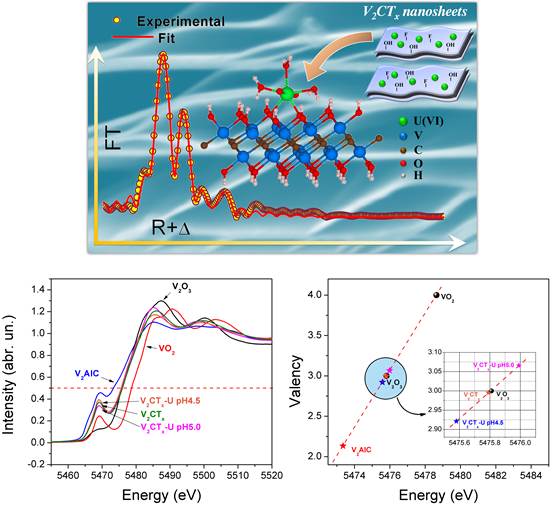| Efficient Uranium Capture by Two Dimensional Vanadium Carbide and Corresponding Interaction Mechanism Study |
| From: PublishDate:2017-06-16 Hits: |
Efficient nuclear waste treatment and environmental management are important hurdles that need to be overcome if nuclear energy is to become more widely used. Recently, two dimensional (2D) transition metal carbide and carbonitride materials (MXene) have garnered great attention in energy and environmental fields. Benefiting from abundant active sites and unique layered structures, MXenes are potential candidates for radionuclide capture. More importantly, this kind of inorganic materials exhibits high radiation resistance and good thermal conductivity, thus can be used for radionuclide separation even under very harsh condition. The Laboratory of Nuclear Energy Chemistry from Institute of High Energy Physics has reported the first case of highly efficient removal of radionuclide by MXene through the capture of uranium on 2D vanadium carbide (V2CTx) as a demonstration. Their research has been published on June 7th, 2016 in ACS Applied Materials & Interfaces. The team firstly synthesized high quality V2CTx by HF etching of V2AlC. The V2CTx material is found to be highly efficient uranium sorbent, evidenced by a high uptake capacity of 174 mg g-1, fast sorption kinetics (4h), and desirable selectivity. Fitting of the sorption isotherm indicated that the sorption followed a heterogeneous adsorption model most probably due to the presence of heterogeneous adsorption sites such as –OH and -F.
The study of interaction mechanism between uranium and V2CTx, and the estimation of equivalent valence of V in V2CTx and V2AlC samples using synchrotron radiation techniques at BSRF.
To further understand the adsorption mechanism,the local coordination environment of U(VI) sorbed onto V2CTx was carefully examined by EXAFS measurement. The analyzed results suggested that the uranyl ions prefer to coordinate with hydroxyl groups bonded to the V-sites of the nanosheets via forming bidentate inner-sphere complexes. Density functional theory (DFT) has also been employed to calculate the most energetically favorable adsorption configuration and coordination information of V2CTx-U complex. They found that the DFT calculations agreed quite well with those obtained from EXAFS results. In addition, the equivalent valence of V in V2CTx and V2AlC samples has been estimated through analyzing the corresponding XANES spectra of V K edge. |
|
|
| Chinese
- Metal-free efficient photocatalyst for stable visible water splitting——Top ten major scientific progresses in China in 2015
- The nano-resolution imaging platform was awarded the first rate prize of Beijing Science and Technology in 2014
- Beamline 1W1 of BSRF started to runoperate in the couplingparasitic mode of BEPCII
- Synthesis of High Performance Polymer Materials for Field Effect-Transistors
- Surfactant molecular aggregates in green solvents
- GIXRD has played an important role in the characterization of organic thin-film transistors
Science Highlights
Home /
Copyright © 2011 - 2012 Beijing Synchrotron Radiation Facility


